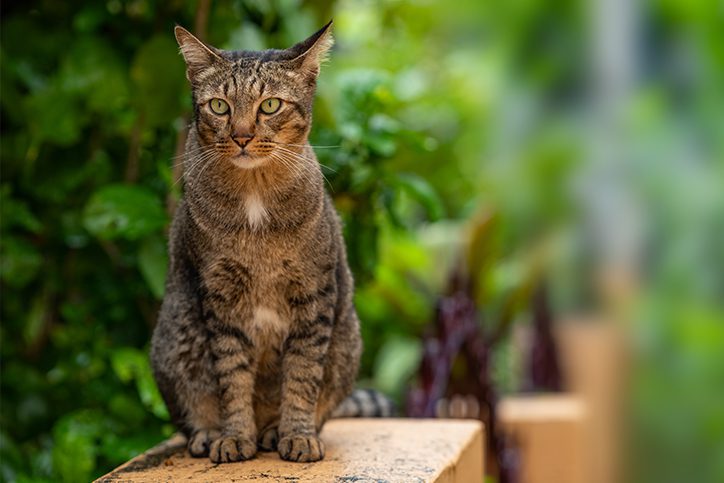What Your Cat is Trying to Say: Cat Body Language in Chicago, IL

Have you ever wondered what your cat would say to you if they could talk? Many humans spend a lot of time wondering what’s going through the minds of their cats, and if you do this too, you’re not alone.
But did you know that you can tell a lot about a cat’s thoughts by paying attention to their body language? In this article, we’ll walk you through some of the basics you need to know about your cat’s body language so you can understand their messages loud and clear.

Tail
Your cat’s tail is one of the most expressive parts of its body, so watch it closely! If your cat’s tail is pointed up or if it’s held comfortably over their back, this means they are happy or satisfied. If her tail is down low, this means they are scared or in pain.
A tail that is flicking back and forth means your cat is annoyed or irritated by something, and you should probably leave them alone for a little while! If your cat is playing, they may wiggle their tail a little bit back and forth or switch it frantically while they are watching their “prey”—probably a favorite cat toy.
Ears
The other most expressive part of a cat’s body is their ears. Your cat’s ears can tell you so much about how they are feeling, so pay attention to them as well. If your cat’s ears are standing up in their natural, erect position, they are content and happy.
If your cat’s ears are perked up very high or slightly forward, they are very alert and are likely watching something carefully. A cat with very forward ears is feeling comfortable and confident. They know what they’re doing, and nothing in their environment is bothering them.
If your cat’s ears are flattened back against their head, they are very angry. You should back away! A cat with ears flattened down more to the sides than straight back is afraid or may be in pain. Your cat’s ears will also turn slightly in response to noises, especially those that they aren’t quite used to.
You might be surprised at all the sounds your cat picks up on if you watch their ears as they move throughout the day. They are listening and paying attention to much more than you think, even while they look asleep!
Eyes
Your cat’s pupils will dilate or constrict significantly depending on the lighting in the area where they are located. However, they also dilate and constrict depending on their mood. A cat who is playing or is chasing something may begin with narrow eyes.
However, shortly before they pounce, their eyes will widen to a much more dilated state so they can see their prey more easily. Watch your cat’s eyes closely when they are thinking about pouncing on something to see this happen.
If your cat isn’t playing and has very wide, dilated pupils, they might be afraid or in pain instead. The context matters a lot when looking at your cat’s eyes to determine what their body language is telling you.
If your cat’s eyes are narrowed and constricted, they may also be angry. They could be close to scratching or biting. If your cat looks at you and blinks very slowly, they are extremely content and happy. Some people feel this is the cat version of saying “I love you” to an owner.
Body
Among the different types of cat body language, the actual body of the cat is perhaps the least expressive. The ears, tail, and eyes can tell you more, but you should still look at your cat’s body and posture to get the whole picture.
If your cat’s posture is relaxed and normal, and if they are pointing their body toward you, this means they are comfortable with you. You can probably pet them without the risk of being scratched.
If your cat arches their back high and their fur stands up, they are scared and trying to make herself look bigger. They may also be playing, however, so again, context is key!
If your cat crouches low to the ground and curls up tightly but is still sitting on their feet (rather than lying down comfortably), they are afraid or in pain.
If your cat rolls onto their back, they’re not asking for a belly rub! They’re just showing you that they feel comfortable around you.
West Loop Veterinary Care & Fear Free Practices
There’s a lot to learn when you’re new to the world of cat body language, and if you’re still having some trouble, don’t worry. Just remember that a cat is much different from a dog or from any other type of pet, and the body language your cat uses is going to vary from the type used by other animals too. We also highly recommend this video as a Cats 101 in understanding body language.
You can always speak with your veterinarian if you have more questions about your cat’s body language. As an animal hospital that utilizes Fear Free® practices, we are very familiar with understanding the fear, anxiety, and stress responses in cats, and when these may be related to an underlying health concern. Don’t hesitate to give us a call at 312-421-2275 or make an appointment to bring your cat to see your West Loop Veterinary Care team.
West Loop:
(312) 421-2275
Streeterville:
(312) 766-5959
